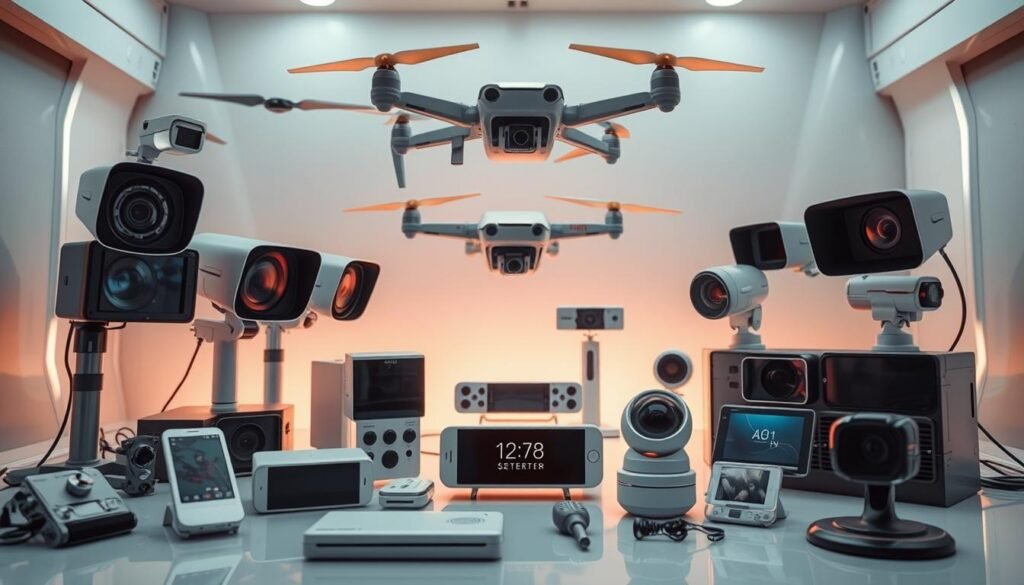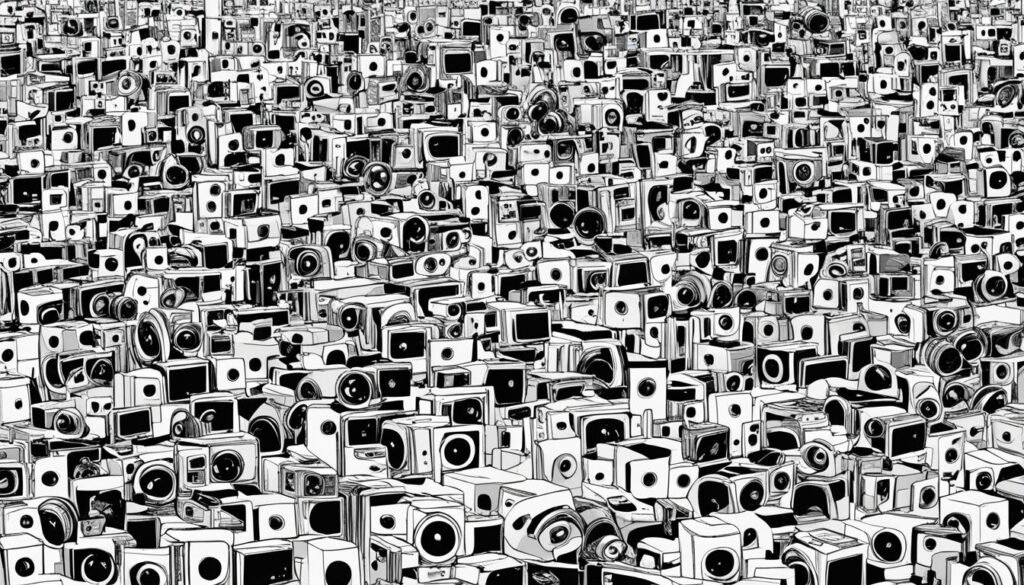Are you truly safe without eyes watching your back? In today’s world, security cameras and video monitoring systems are key for keeping our homes, businesses, and public areas safe. The market for surveillance technology is growing fast, with new, advanced solutions coming out quickly.
The global video surveillance market is expected to hit US$ 53.47 billion by 2023. Experts say it will keep growing, at a rate of 12.98% each year until 2033. This growth is thanks to new tech in security cameras and monitoring systems, making them more effective than ever.
As cities grow and new projects start, the need for strong security solutions gets bigger. Some might worry about the cost at first, but the long-term benefits are huge. Surveillance equipment helps prevent crime and provides important evidence, keeping our communities safe and secure.
Understanding the Rise of Video Surveillance Market
The video surveillance market has grown a lot in recent years. By 2023, it reached a size of US$ 53.47 billion. Experts believe it will keep growing, with a 12.98% annual growth rate from 2023 to 2033.
Market Size and Growth Projections
The security industry is growing fast, thanks to a high demand for CCTV systems. North America is leading the market, followed by Europe and Asia Pacific. This growth is driven by increasing spending on defense and public safety around the world.
Key Players in the Industry
Ten major companies are leading the video surveillance market. Hikvision, Dahua, Axis Communications, and Bosch Security Systems are among them. Other big names include FLIR, Avigilon, Hanwha Techwin, Honeywell Security Group, Infinova, and Pelco.
Technological Advancements Driving Growth
New technologies are changing the market. It includes analog, IP, and hybrid systems. The market is made up of hardware, software, and services. AI and machine learning are making threat detection and analytics better in surveillance equipment.
Types of Surveillance Equipment
The world of surveillance equipment has grown a lot, offering many tools for security. Spy gear has advanced a lot, with new technologies for different needs. These devices help protect and monitor places like offices and homes.
Hidden cameras are great for secret watching. They look like normal things, making them perfect for hidden use. Some can record in high definition and let users watch their place from anywhere.
Audio surveillance devices are key for hearing what’s going on. They come in small microphones and big listening devices. They work with cameras to give a full view of what’s happening.
There are also advanced tools like 3D cameras and LiDAR sensors. These new technologies help recognize objects and know the space better. This makes security better in many areas. We’ll likely see more new surveillance tools as technology gets better.
The Role of AI and Machine Learning in Modern Surveillance
AI-powered surveillance is changing how we keep places safe. Now, 75% of 176 countries use AI in their surveillance cameras. This big change shows how much smarter we can monitor things now.
Real-Time Threat Identification
Machine learning security systems are great at catching threats as they happen. They can spot strange behavior or objects right away. This means security teams can react quickly when it’s important.
Enhanced Analytics Capabilities
Smart monitoring does more than just record video. It can analyze patterns, track movements, and even recognize faces. This detailed analysis helps security teams understand what’s going on better.
Integration with Existing Security Systems
AI-powered surveillance doesn’t replace old systems; it makes them better. It works with what we already have to create a stronger security network. This mix of old and new tech means better protection overall.
The future of surveillance is here, thanks to AI and machine learning. As these technologies improve, we’ll see smarter, more effective security solutions ahead.
Surveillance Equipment for Smart Cities
Smart cities are using the latest in urban security to face today’s challenges. They use advanced cameras and monitoring systems to keep people safe, manage traffic, and use resources better. The market for these smart city solutions is growing fast, with big names like Cisco, IBM, and Microsoft leading the way.
In North America, the U.S. is a big player in the Smart City Platforms market. But Asia-Pacific, especially China and India, is growing fast thanks to more people moving to cities and government support. Smart utilities are a big part of this market, thanks to the need to manage resources better.
Urban security is getting a boost from monitoring road infrastructure. Researchers are working on systems that use phone cameras to make detailed maps of roads. This tech aims to use AI and machine learning to check road conditions automatically, making it easier to keep roads safe.
Public safety cameras are really helping to cut down on crime. In Oakland, California, crime went down by 66% after they put in a system that could detect gunfire. Cities like Dubai, Philadelphia, and Shanghai are also seeing crime drop by up to 50% in some areas by using data to guide police work.
Smart emergency systems are key to keeping cities safe. Japan has a system that warns people before earthquakes hit. Switzerland uses drones to help with mountain rescues. And London keeps an eye on fire hydrants with smart monitoring, making emergencies safer and faster to handle.
3D Surveillance Cameras: The Next Frontier
3D security cameras are changing the game in surveillance. They bring a new level of depth and awareness to security. This makes them key in many areas.
Benefits of 3D Technology in Surveillance
These cameras are great at recognizing objects and measuring distances. This means they can spot threats more easily and cut down on false alarms. LiDAR surveillance, a part of 3D tech, makes detailed 3D maps of areas. This gives a clear view of what’s happening.
Applications Across Various Sectors
3D cameras are used in airports, factories, and smart cities. At airports, they help screen passengers better. In factories, they watch over production lines to prevent accidents. Smart cities use them for traffic and public safety.
Future Prospects and Innovations
The future of 3D surveillance is bright. Adding AI and machine learning will make these systems even better. We’ll see quicker and more accurate threat detection. As technology grows, 3D cameras will be key in making places safer and more efficient.
Implementing Surveillance Equipment in Commercial Spaces
Business security systems are key to protecting assets and keeping workplaces safe. Commercial CCTV is now common in many sectors, from shops to factories. These systems do more than stop theft; they also improve operations and boost productivity.
Monitoring at work has grown beyond just watching cameras. Today, business security systems use AI and analytics. This tech spots threats in real-time and responds fast to security problems. In shops, smart cameras watch how customers move, helping stores arrange products better.
How CCTV is used changes with each industry. Banks use high-resolution cameras for clear facial ID. Factories might use thermal cameras to spot equipment issues. The aim is always to make work safer and more efficient.
When putting in security systems, think about privacy for employees. Being open about why and how you’re monitoring can keep trust high. With careful planning, surveillance can make places safer without hurting morale.
Residential Applications of Surveillance Systems
Home security cameras are key to keeping families and homes safe. They have become more popular with smart home surveillance. Now, homeowners have more control and advanced features in their security systems.
Home Security Solutions
Modern cameras offer clear video, night vision, and can detect motion. These features scare off intruders and help prove a break-in later. You can watch your home on your smartphone, giving you peace of mind when you’re away.
Integration with Smart Home Technology
Smart surveillance systems work well with other devices. You can control cameras, locks, and lights from one app. This makes your home safer and more convenient. For example, cameras can turn on lights when they sense motion, scaring off intruders.
Privacy Considerations for Residential Use
While monitoring your home has many benefits, privacy is a concern. Make sure outdoor cameras don’t invade your neighbors’ privacy. Inside, decide where cameras can go and keep video feeds secure. Use encryption and update passwords often to protect your footage.
The video surveillance market is growing fast, reaching $53.47 billion in 2023. It’s expected to grow by 12.98% from 2023 to 2033. This means we’ll see more advanced home security solutions soon.
Legal and Ethical Considerations in Surveillance Equipment Usage
The use of surveillance equipment has raised questions about privacy and security. Laws on surveillance differ by region, so it’s important to know the local rules. These laws aim to protect our privacy while still allowing for needed monitoring.
It’s key to use surveillance in an ethical way to keep the public’s trust. Companies need to balance security with privacy. This means handling data carefully, limiting who sees the footage, and having clear rules on when to use surveillance.
Being open about surveillance is crucial. Companies should tell people when cameras are being used and why. Some places, like bathrooms and changing rooms, should not be watched because they are private.
As technology gets better, laws on surveillance change too. It’s important for users to keep up with these changes. Doing regular checks on how surveillance is used can help spot and fix any legal or ethical problems.
Finding the right balance between security and privacy is hard. By following the law, respecting privacy rules, and being ethical, companies can use surveillance in a responsible way.
Choosing the Right Surveillance Equipment for Your Needs
Finding the perfect surveillance system can be hard. A good security camera buying guide helps make a smart choice. First, think about what you need. Are you protecting a home, business, or a big area? Each place needs different gear.
For homes, think about wireless cameras that are easy to set up and work with your phone. Businesses might want stronger systems with high-quality cameras and lots of storage. Big areas need a mix of cameras inside and outside, plus systems to control access.
Custom security solutions are often the best choice. Consider the camera’s quality, how much storage you need, and how it works with other systems. Don’t overlook AI features – they can make your system much better. Some cameras can recognize faces and send alerts in real-time.
The aim is to balance security with what you can afford. Spend time looking at different options. Many companies let you try before you buy with free trials or demos. By thinking about your needs and checking out what’s available, you’ll find the perfect security solution.


